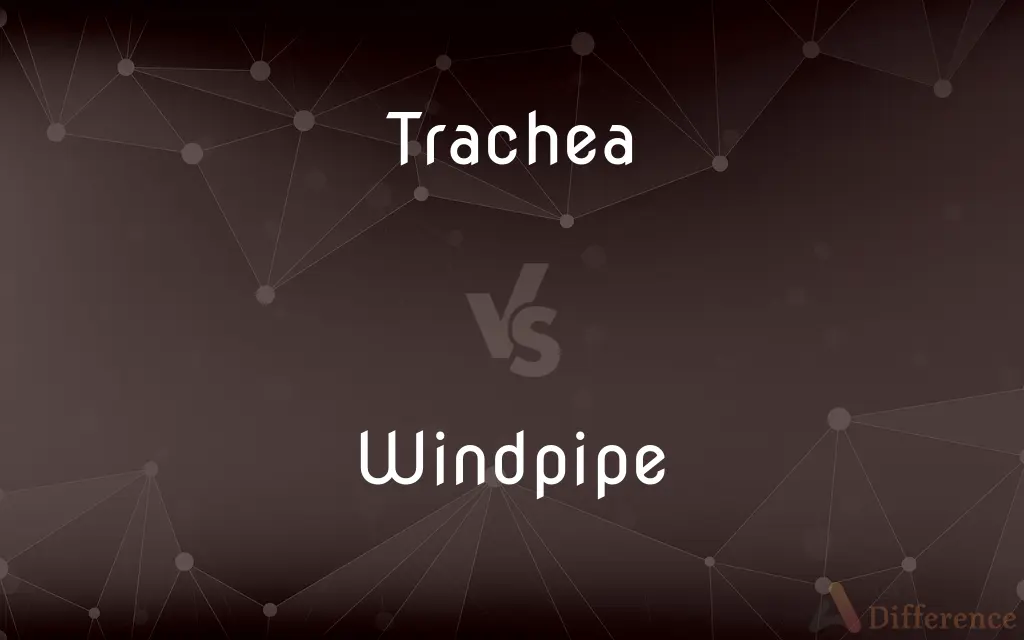Trachea vs. Windpipe — What's the Difference?
By Tayyaba Rehman & Maham Liaqat — Updated on March 24, 2024
The trachea, often called the windpipe, is a crucial part of the respiratory system; while both terms refer to the same structure, "trachea" is the medical term and "windpipe" is the common term.

Difference Between Trachea and Windpipe
Table of Contents
ADVERTISEMENT
Key Differences
The trachea, also known as the windpipe, is a vital tube in the respiratory system that allows air to move from the larynx to the lungs. Whereas "trachea" is the term used in medical and anatomical contexts, "windpipe" is the everyday term used by the general public. This distinction highlights the difference between clinical and layman's terminology.
The trachea is characterized by its rigid structure, supported by C-shaped rings of cartilage, which prevent the airway from collapsing. On the other hand, the term "windpipe" doesn't convey the anatomical features or the functional importance of the trachea, focusing instead on its role in conducting air.
In medical diagnostics and treatment, the term "trachea" is used to ensure precision and clarity. Whereas "windpipe" might be used in less formal contexts, such as patient education and casual conversation, to ensure understanding without medical jargon.
The trachea's role in the respiratory system is crucial for gas exchange and is often examined in medical settings for blockages or diseases. Meanwhile, the term "windpipe" might be more commonly found in discussions of choking hazards and first aid measures, emphasizing its role in breathing.
Understanding the structure and function of the trachea is essential for healthcare professionals and students in the medical field. In contrast, the term "windpipe" is more accessible for those without a medical background, making the concept of the airway more relatable.
ADVERTISEMENT
Comparison Chart
Term Usage
Medical and scientific contexts
Everyday, non-scientific contexts
Structure
Supported by C-shaped cartilage rings
Same structure, but the cartilaginous aspect is not emphasized
Function
Facilitates air movement to the lungs
Emphasized as the air passage in breathing
Relevance
Focus in medical diagnosis and treatment
Common in discussions of choking and first aid
Audience
Healthcare professionals and students
General public without medical background
Compare with Definitions
Trachea
It is a crucial part of the human respiratory system.
The trachea divides into two bronchi, leading to each lung.
Windpipe
The windpipe is a common term for the trachea, the airway to the lungs.
He felt something stuck in his windpipe and started coughing.
Trachea
Medical conditions like tracheitis involve inflammation of the trachea.
Tracheitis can cause severe breathing difficulties.
Windpipe
It is often mentioned in the context of breathing and speaking.
Air passes through the windpipe when we breathe or speak.
Trachea
Intubation procedures often involve the trachea.
The paramedic performed an emergency intubation through the trachea.
Windpipe
First aid techniques like the Heimlich maneuver target the windpipe.
The Heimlich maneuver can dislodge objects from the windpipe.
Trachea
The trachea is the main airway to the lungs, supported by cartilage rings.
The doctor examined the trachea for any signs of obstruction.
Windpipe
Casual discussions about respiratory health might refer to the windpipe.
She felt a tickle in her windpipe and coughed to clear it.
Trachea
The trachea is lined with ciliated epithelium.
The cilia in the trachea help trap and expel foreign particles.
Windpipe
The windpipe can become blocked, leading to choking.
Food stuck in the windpipe is a common choking hazard.
Trachea
The trachea, also known as the windpipe, is a cartilaginous tube that connects the larynx to the bronchi of the lungs, allowing the passage of air, and so is present in almost all air-breathing animals with lungs. The trachea extends from the larynx and branches into the two primary bronchi.
Windpipe
See trachea.
Trachea
(Anatomy) A thin-walled, cartilaginous tube descending from the larynx to the bronchi and carrying air to the lungs. Also called windpipe.
Windpipe
The trachea.
Trachea
(Zoology) One of the internal respiratory tubes of insects and some other terrestrial arthropods, which are connected to the spiracles and are used for gas exchange.
Windpipe
Any duct for air or other gas.
Trachea
(Botany) A tracheary element.
Windpipe
(rare) A section of road or bridleway which has a reputation for having strong crosswinds or localized wind swirls.
Trachea
(anatomy) A thin-walled, cartilaginous tube connecting the larynx to the bronchi.
Windpipe
The anus.
Trachea
The xylem vessel.
Windpipe
The passage for the breath from the larynx to the lungs; the trachea; the weasand. See Illust. under Lung.
Trachea
(entomology) One of the cuticle-lined primary tubes in the respiratory system of an insect, which extend throughout its body.
Windpipe
Membranous tube with cartilaginous rings that conveys inhaled air from the larynx to the bronchi
Trachea
The windpipe. See Illust. of Lung.
Trachea
One of the respiratory tubes of insects and arachnids.
Trachea
One of the large cells in woody tissue which have spiral, annular, or other markings, and are connected longitudinally so as to form continuous ducts.
Trachea
Membranous tube with cartilaginous rings that conveys inhaled air from the larynx to the bronchi
Trachea
One of the tubules forming the respiratory system of most insects and many arachnids
Common Curiosities
Can the trachea be affected by medical conditions?
Yes, conditions like tracheitis involve inflammation of the trachea, which can affect breathing.
What are the functions of the trachea?
The trachea facilitates air movement to the lungs for respiration and is lined with cilia to trap and expel foreign particles.
What is the trachea?
The trachea, or windpipe, is the main airway that connects the larynx to the lungs, allowing for air passage.
Why is the trachea also called the windpipe?
"Windpipe" is the common term for the trachea, reflecting its role in conducting air (or "wind") to the lungs.
What is the significance of the cartilage rings in the trachea?
The C-shaped cartilage rings provide structural support to the trachea, preventing it from collapsing and ensuring open air passage.
Can animals have trachea issues similar to humans?
Yes, animals also have tracheas that can be subject to similar issues as humans, including blockages and infections.
How is the trachea examined medically?
Medical professionals may use imaging techniques or endoscopy to examine the trachea for blockages or diseases.
What happens if the trachea is blocked?
A blocked trachea can lead to choking and obstructed air flow, requiring immediate medical attention or first aid.
How do first aid techniques relate to the windpipe?
Techniques like the Heimlich maneuver are designed to clear obstructions from the windpipe, preventing choking.
How does the trachea differ from the esophagus?
The trachea is part of the respiratory system, allowing air passage to the lungs, while the esophagus is part of the digestive system, guiding food to the stomach.
Is the windpipe visible or palpable from the outside?
The trachea can sometimes be felt through the skin in the neck, especially in thin individuals or when the neck is extended.
Are there surgical procedures related to the trachea?
Yes, procedures like tracheostomy involve creating an opening in the trachea to bypass upper airway obstructions.
Can the windpipe become irritated?
Irritants like smoke or dust can cause coughing and discomfort in the windpipe, signaling the body to expel them.
How does the trachea protect the lungs from infection?
The mucous and cilia lining the trachea trap pathogens and dust, preventing them from reaching the lungs.
How is the health of the trachea maintained?
Maintaining overall respiratory health, avoiding smoking, and preventing inhalation of harmful substances help keep the trachea healthy.
Share Your Discovery

Previous Comparison
Joker vs. Riddler
Next Comparison
Shawarma vs. DonerAuthor Spotlight
Written by
Tayyaba RehmanTayyaba Rehman is a distinguished writer, currently serving as a primary contributor to askdifference.com. As a researcher in semantics and etymology, Tayyaba's passion for the complexity of languages and their distinctions has found a perfect home on the platform. Tayyaba delves into the intricacies of language, distinguishing between commonly confused words and phrases, thereby providing clarity for readers worldwide.
Co-written by
Maham Liaqat














































